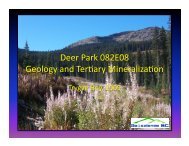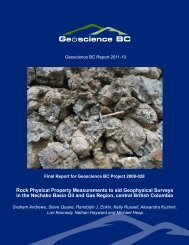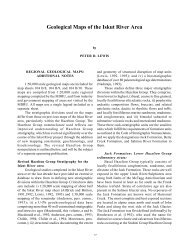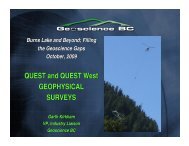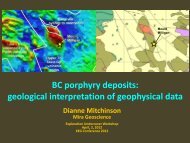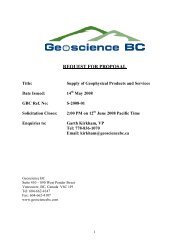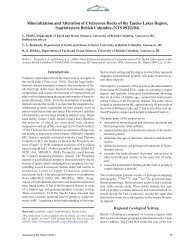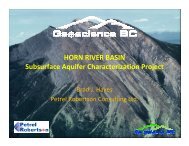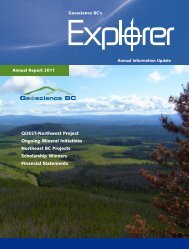Final Report - Geoscience BC
Final Report - Geoscience BC
Final Report - Geoscience BC
Create successful ePaper yourself
Turn your PDF publications into a flip-book with our unique Google optimized e-Paper software.
4. Correlation of Measurements with Rocks4.1. Magnetic SusceptibilityMagnetic ground, airborne surveys and magnetic susceptibility data is commonly available andrelatively inexpensive to acquire. High resolution airborne magnetic surveys are increasinglycovering the land and can reveal the detail of geological structure within the 200 m of thesurface. As a result inversions and 3D models of magnetic data are commonly used byexploration companies. Magnetic susceptibility is controlled by accessory minerals in a rock,principally terrimagnetic magnetite and pyrrhotite, distribution of which may not be uniform forsuch reasons as concentration in distinct layers, uneven hydrothermal alteration or variableconditions of differentiation, eg. oxygen fugacity in plutonic rocks. The upside of application ofmagnetics is that magnetic susceptibility measurements are easy to collect in the field and drillcores. The degree of variation of magnetic susceptibility is much greater than density, zero to300 x 10 -3 SI compared to 2.0 to 3.2 g/cm 3 . As a result much more variation and apparent detailcan be seen on high resolution magnetic maps, particularly first derivative maps. (Figs. 9 and 10Thomas). Geological units can have varying amounts of magnetic remanence with a suppressedsignal on airborne magnetics.. To understand the potential for remanence get type rock samplesmeasured for magnetic remanence and induced magnetism. The relative dominance ofremanence over induced magnetism is reported as Koenigsberg ratio or Q values.4.2. DensityDensity reflects mainly the principal minerals that constitute and define a particular rock type,eg. quartz, feldspar and pyroxene. In most rock types the defining mineralogy is essentiallyuniform, hence density characteristics are also uniform. For this reason density variation is apreferred method for mapping rock units. Intrepid Geophysics’ surveys of the Broken Hillterrane reported that that mapping of the variance of the density, the standard deviation, is aneffective way of mapping rock units. Gold exploration has found gravity effective at mapping thegeometry and structure of greenstone belts and specific intrusion targets in greenstones orsedimentary formations. On the downside it is expensive to acquire ground and airborne gravitysurveys in sufficient detail to image geology. The increasing access to airborne gravitygradiometer surveys means that in the future more density inversions will be possible. The AGG5





